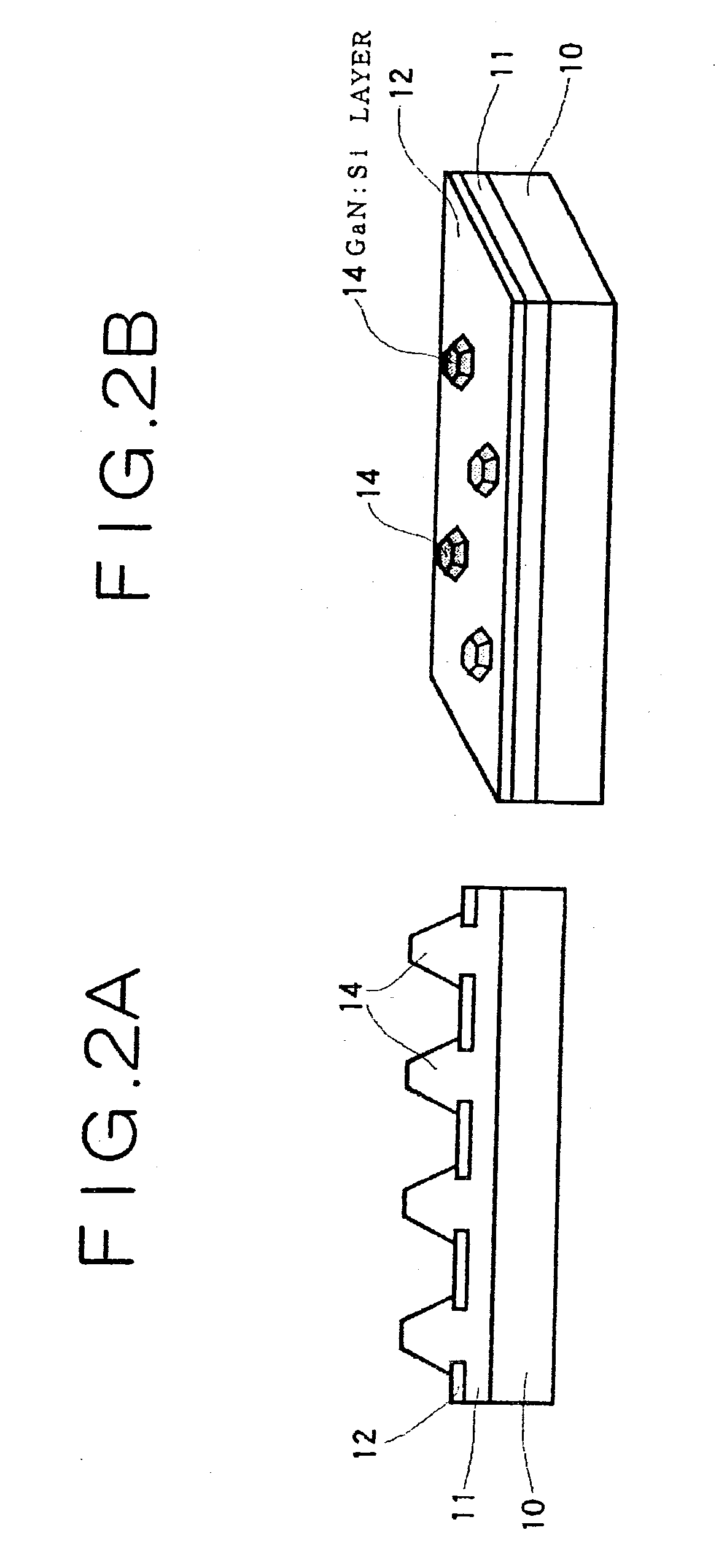Semiconductor light-emitting device and semiconductor light-emitting apparatus
a technology which is applied in the field of semiconductor light-emitting device and semiconductor light-emitting apparatus, can solve the problems of difficult to keep crystallinity at a high level, the inability to obtain good light-emitting characteristics, and the inability to form light-emitting elements in high precision, so as to improve the luminous efficiency, and improve the effect of crystallinity
- Summary
- Abstract
- Description
- Claims
- Application Information
AI Technical Summary
Benefits of technology
Problems solved by technology
Method used
Image
Examples
example 1
[0110] This example deals with direct selective growth on a sapphire substrate wherein a selective crystal growth layer having different crystal planes including an S plane and a C plane, and regions of the S plane and regions of the C plane are divided from each other and independent p-electrodes corresponding to two color light-emitting wavelengths are formed. With reference to FIGS. 1 to 6, an element structure is described along with a fabrication process thereof.
[0111] First, a low temperature buffer layer made of either AlN or GaN is formed on a sapphire substrate 10 having a C+ plane as a principal plane thereof at a low temperature of 500.degree. C. Thereafter, a mask layer 12 made of SiO.sub.2 or SiN is formed over the entire surface in a thickness ranging from 100 to 500 nm, and openings 13 with a size of approximately 10 .mu.m are formed according to photolithography by use of a hydrofluoric acid etchant (FIG. 1). In this example, the opening 13 is substantially in a roun...
example 2
[0121] This example is one which deals with direct selective growth on a sapphire substrate wherein a selective crystal growth layer having an S plane is formed and independent p-electrodes corresponding to two color light-emitting wavelengths are formed on the plane portion and the side portion of the S plane. Referring to FIGS. 7 to 12, the element structure is described along with its fabrication process.
[0122] First, a low temperature buffer layer made of either AlN or GaN is formed on a sapphire substrate 30 having a C+ plane as a substrate principal plane at a low temperature of 500.degree. C. After raising to a temperature of 1000.degree. C., a silicon-doped GaN layer 31 is formed. Subsequently, a mask layer 32 made of SiO.sub.2 or SiN is formed over the entire surface in a thickness ranging from 100 to 500 nm, and openings 33 with a size of approximately 10 .mu.m are formed according to photolithography using a hydrofluoric acid etchant (FIG. 7). In this example, the opening...
example 3
[0132] This example is one which deals with direct selective growth on a sapphire substrate wherein a selective crystal growth layer having an S plane is formed and independent p-electrodes corresponding to three color light-emitting wavelengths are formed. Referring to FIGS. 13 to 18, the element structure is described along with its fabrication process.
[0133] First, a low temperature buffer layer made of either AlN or GaN is formed on a sapphire substrate 50 having a C+ plane as a substrate principal plane thereof at a low temperature of 500.degree. C. After raising to a temperature of 1000.degree. C., a silicon-doped GaN layer 51 is formed. Subsequently, a mask layer 52 made of SiO.sub.2 or SiN is formed over the entire surface in a thickness ranging from 100 to 500 nm, and openings 53 with a size of approximately 10 .mu.m are formed according to photolithography using a hydrofluoric acid etchant (FIG. 13). In this example, the opening 53 is substantially in a round shape, and th...
PUM
 Login to View More
Login to View More Abstract
Description
Claims
Application Information
 Login to View More
Login to View More - R&D
- Intellectual Property
- Life Sciences
- Materials
- Tech Scout
- Unparalleled Data Quality
- Higher Quality Content
- 60% Fewer Hallucinations
Browse by: Latest US Patents, China's latest patents, Technical Efficacy Thesaurus, Application Domain, Technology Topic, Popular Technical Reports.
© 2025 PatSnap. All rights reserved.Legal|Privacy policy|Modern Slavery Act Transparency Statement|Sitemap|About US| Contact US: help@patsnap.com



